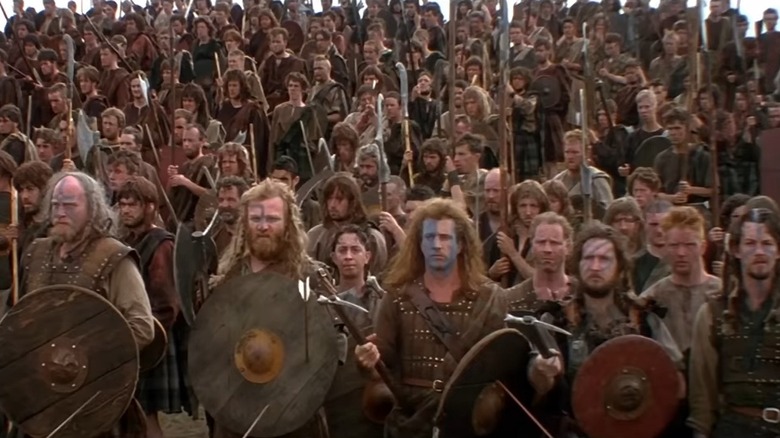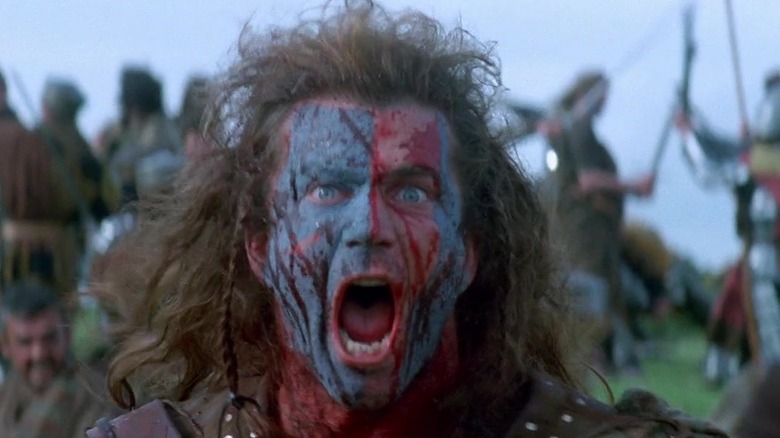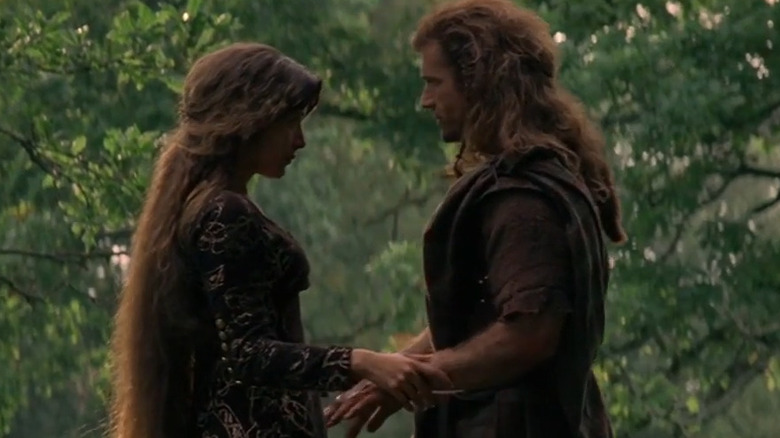How Braveheart Tried To Find The Right Balance Of Brutality
As the newest generation of epic war stories has come to the big and small screen—I'm talking, of course, about the Battle of the Bastards from "Game of Thrones," the final showdown in Ripley Scott's "The Last Duel," or the sprint across the battlefield from "1917"—the absolutely brutal violence depicted tends to match how my memory recalls movies like "Braveheart," "Gladiator," "The Patriot," and "The Last Samurai." When revisiting these great R-rated period dramas of the mid-90s to mid-2000s, however, I am often struck by how tame they can be in their depiction of war. Instead of showing us the vivid gore that will burn itself onto the back of our eyelids, as many contemporary filmmakers have done, these films are a bit more thoughtful with how they approach violence.
Through this lens, "Braveheart" serves as an archetypal example. The true story behind Braveheart is no doubt an intense one, with the historical figure William Wallace suffering the fate of being beheaded by the English. To make matters even more alarming for the real-life man, the English sought to send a message to the Scots by mounting Wallace's head on London Bridge for the public to witness. As opposed to reveling in the bloody murder that is a beheading, which today's film and television might not hesitate to show, "Braveheart" uses this final act moment as an emotional and romantic scene by cutting away to Wallace reflecting on his lost childhood love. Throughout "Braveheart," director Mel Gibson makes many similar choices that prioritize story over shock factor.
Chasing the R-rating
Gibson's first cut of the film was apparently not as subdued as the final product. As the story of "Braveheart's" production goes, Gibson had to purge the excessive violence, including Wallace's disembowelment, from a nearly four-hour cut of the film that would have earned it an NC-17 rating from the Motion Pictures Association (MPA). That said, what remains is not without its brutality. The final Battle of Stirling includes some truly barbaric moments, as swords skewer torsos, axes crack skulls, and knives slit throats while blood sprays the camera lens. For most of American cinematic history before "Braveheart," the violence shown would not have been well received, and even today, it remains a film that young children should not see.
Writer of "Braveheart" Randall Wallace (who has no relation to William) commented on the violence in the film and the lengths that Gibson went to strike an appropriate balance, saying, "I always think of the line, 'You never know what is enough, until you know what is too much.'" With the levels of violence tolerated in today's cinema, it is easy to see how "Braveheart" might have been holding back. Cuts to violence are short, effective, and not quite as bloody as they could be. Graphic beheadings and disembowelments were selectively avoided. In riding the line of acceptability, however, the irony is that "Braveheart" also likely pushed it to where it stands today.
Why hold back the brutality?
"Braveheart" may be a genre-defining film, but it is rarely lauded for its historical accuracy, with one of the most obvious examples being its demotion of William Wallace from the nobleman he actually was to the Scottish peasantry class. "Braveheart" instead tries to capture how Wallace would go down in history as a mythic figure. The film takes a similar approach to its violence. While not always historically or even anatomically accurate, it harnesses the spirit of battle and the epic rivalries of kingdoms and culture in the age of the British Empire.
Randall Wallace articulated this well when commenting on how even communities that are highly averse to violence, such as churches or conservative universities, still celebrate the film. The writer of "Braveheart" has asked, "'Does this violence feel gratuitous and put in for the sake of pandering to the lowest urges of people,' or 'Does this violence tell people this is how desperate life can be and this is why love and courage and sacrifice are not just desirable—they're crucial.'" Like other successful historical epics, "Braveheart" portrays the essence of great moments in history rather than the history itself. This approach does not always need to be as brutal as possible but can exercise restraint, which results in a better story.


